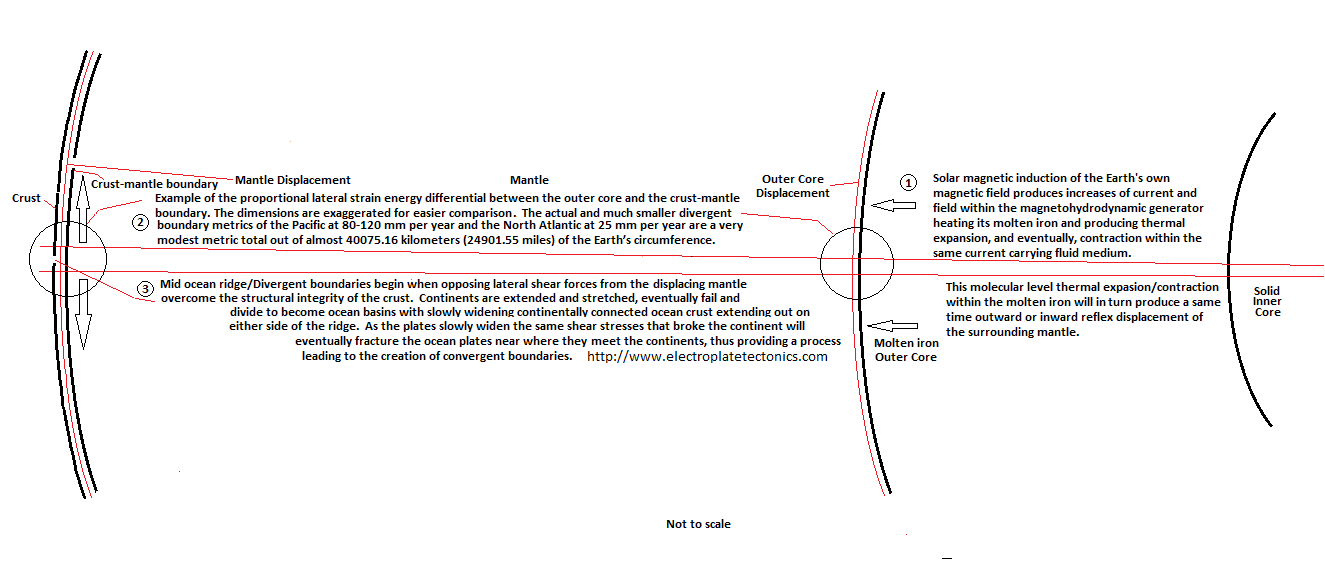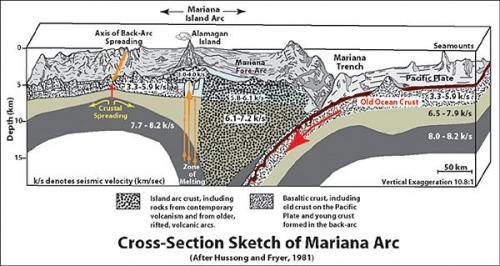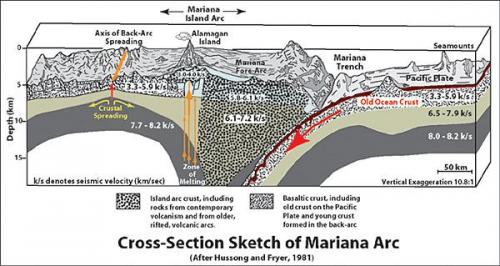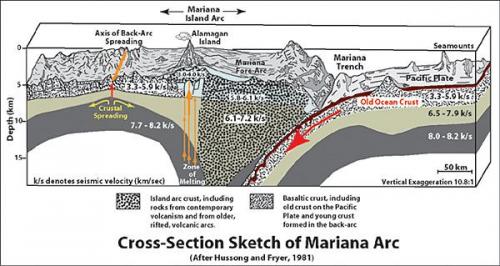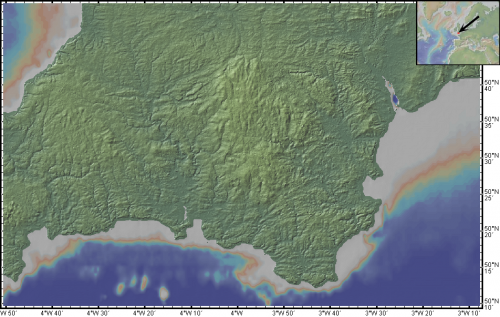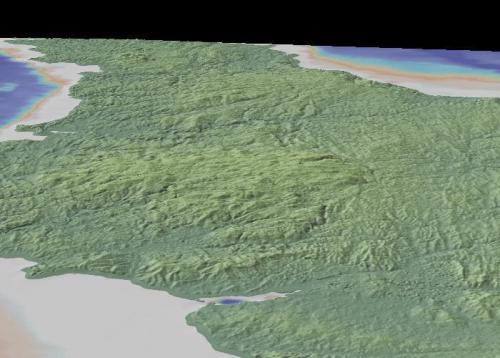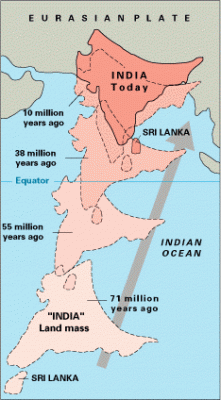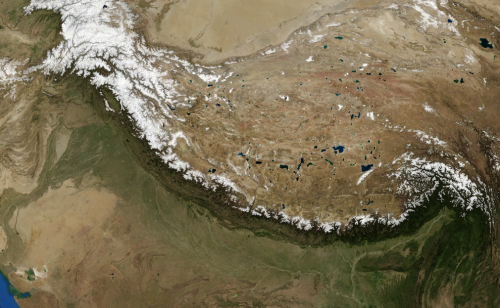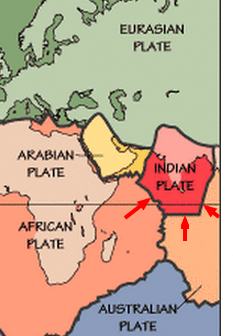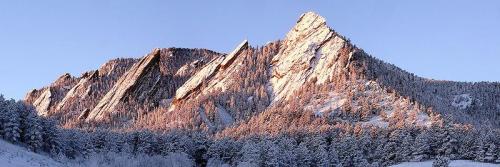-
Posts
978 -
Joined
-
Last visited
Content Type
Profiles
Forums
Events
Everything posted by arc
-
Hi Mike; The back-arc spreading center, to the left in the image, is a divergent spreading process similar to the mid-ocean ridges. But as I described above it would be activated by the ebb and flow of the subduction process during contraction of the core-mantle from decreased current amplitude, in addition to being separated during extension of the crust by the mantle during the periods of increased thermal expansion. I would expect the subduction driven spreading to be small while the expansion spreading would be conciderably more. Its movement is due to the subducted plate sections expanse producing proportionate kinetic energy movement as described in post 7. According to Wikipedia; Spreading rates vary from very slow spreading (Mariana Trough), a few centimeters per year*, to very fast (Lau Basin), 15 cm/year. This infill material would be ocean crust like any other. *As a side note; this low level of movement of the Mariana Trough is due to the decoupled and fractured end of that ocean plate section to the east (see post 6) that slips and reduces the ocean plates ability to acquire the tension needed during thermal expansion to pull the spreading center open. The other "new" crust material is being deposited on top of the existing historic ocean crust that underlies the axis of the island arc chain. "new crust is forming along the island arc (from deep melting of the down going plate)" This material is forming the sub-surface volcanic structures that may break the ocean surface and eventually combine to form large island arc structures similar to those like Japan, Philippines and Malaysia. Image courtesy NOAA Ocean Explorer. Imagine the compressed and subducted ocean plate where it bends at the top of the trench. (see image) The subducting crust is pushed by the compression towards the overriding plate. This causes the overriding plates vertical movement that produces a fore arc structure and the tension fracturing of that plates underside that will precipitate the movement of magma through those fractures to the sea floor surface where it will accumulate to form the growing island arc structures, notice the volcano above the "Zone of Melting". The accumulation of crustal deposits that are scraped off the surface of the subducting plate form the accretionary wedge that contributes to the fore arc development. Thanks, arc Hello Tim, I'm glade to hear from you again. I think that is a fundamentally important question and it never occurred to me, I should have investigated it. If you look at the image you will see some numbers like 6.5 - 7.9 k/s. These are seismic velocities indicating the speed in kilometers per second. The higher the number indicates more distance per second which I believe also indicates greater densities. It looks like the mantle is the highest density. Thanks, arc
-
This eruption looks to be, by volcanic standards, a small steam related event. It looks like some prior rain was deposited in the crater where gravity and an inclined terrain provided a means to load a charge of propellant into a makeshift chamber of a steam driven cannon. The rain water was able to quickly flow into a deposit of extremely hot ash producing the explosive eruption. This appears to be more of a secondary response by an outside trigger to an existing thermal content in the crater. Island Arc volcano's are a difficult mechanism to understand. This 3-D sketch (left) shows a cross-section of the Mariana Arc with some of its main structures and features. The numbers represent the speed of sound in the various layers beneath the arc measured by the precise timing arrivals from earthquakes and man-made sources. Higher velocities represent more dense material. Note that there is old ocean crust descending in the trench at the same time new crust is forming along the island arc (from deep melting of the down going plate) and in the back-arc spreading center (from extension behind the arc). Modified from Plate 2 of Fryer and Hussong (Proceedings of the Deep Sea Drilling Project, Leg 60, pp. 45-55, 1981). Image and text courtesy NOAA Ocean Explorer. In both the standard and my model the descending ocean plate is melting into the asthenosphere, the accompanying friction adding to the melting of the surrounding rock into magma, some of which is forced to the surface building up the volcanic island chains. In my model there is an additional mechanism that produces the observable phenomena of island arcs and may actually allow for larger eruptions. Picture in your mind that image above. The mantle is slowly moving down, unloading the crust's gravitational potential energy into the trench in an ebb and flow of movement over millions of years. The compression loading up and then slowly relieving then repeating over and again. The trenches rate of resistance varying as the surrounding mantle is heated from the increasing compression. This in turn will decrease resistance and increase movement. The increase of compression will increase the curvature of the ocean plate at the trench, moving it towards the island arc and compressing the island arc structure all the way to the back arc spreading center, decreasing magma flow to the surface in the entire complex. This compression in the ocean plate is what is also producing increased friction, pressure and melting. The thermal energy builds as the kinetic changes into compression. The stage is now set for a volcanic eruption when the compression is relieved as the ocean plate melts away. As the compressed ocean plate relaxes the volcanic vents release the pent up energy of the lower regions. This cycle would fit nicely to the historic record of island arcs.
-
Well, to be honest I thought this would create a lot more resistance from those committed to the standard model. I had an image of hitting a hornets nest with a stick. I think the hornets are still around I just need a bigger stick. So with that in mind I begin what I think will be a difficult post for some people. WARNING! The following post may challenge some people's rigid inflexible understanding of the Earth's current and controversial heat flux dynamics. The mantle in this model is displaced by the thermal expansion of the outer core's liquid iron from the increased amplitude of current within the magnetic field's magnetohydrodynamic generator. The mantle's outward movement, against the force of gravity, produces a strain energy response as the mantle's viscosity resists the expansion, creating thermal heating of the mantle material as the strain tension is released. The strain energy response and thermal release increases proportionally to the distance from the mantle-core boundary, culminating at the crust-mantle boundary with maximum expansionary movement and strain energy thermal heating. The mantle's outer boundary surface area is stretched out and torn producing localized pressure reduction thus allowing melting of the surrounding surface area materials. This thermal heating of the crust-mantle boundary coincides with the expansionary movement of the crust by the displaced mantle, giving researchers a way to measure and calibrate the thermal forcing of Earth's ocean and atmosphere to historic periods of plate tectonic expansion and contraction. As an example, the extension of the Basin and Range Area is dated to the Miocene Epoch (5.3 - 23.03 MYA). The province is believed to be the result of tectonic extensional processes that began around 17 MYA (million years ago) in the Early Miocene. It was considered a warmer climate period than the following Pliocene and Pleistocene Epochs that were cooler periods of climate that coincide with the Himalayan and Andes mountain building periods. These structures would require large scale subduction and displacement of crustal gravitational potential energy into the folded and raised rock strata. These mountain structures occurred while the Earth's climate went into a period of Ice Ages. This model gives significant, but not unambiguous, evidence that the thermal variability of the outer core produces coordinated geologic restructuring and climate forcing. arc
-
studiot, It sound's great. But if it's at the level of some of the material I found on the web it may be over my head. I'm shooting from the hip on this. You folks can leave me in the dust just walking to the car. About the mantle's displacement and strain energy, I'm wondering if according to this: http://newscenter.lbl.gov/news-releases/2011/07/17/kamland-geoneutrinos/ the current 22 terawatts of unaccounted internal heat could be the result of a slow strain energy movement in the mantle. And could the current sea floor spreading metrics be used as a value for calculating and verifying the mantles degree of displacement and strain energy thermal release. arc Hello Moontanman, It looks to me like the classic "rookie overcompensation" mistake on my part, urp..sorry I just threw-up in my mouth. What can I say, first CaptainPanic then Ophiolite I freaked and started throwing everything out there to stop the hemorrhaging. O.k. seriously you people will have to occasionally deal with my "flee market hypothesis" approach. Just dig through the pile of worthless crap until you get something useful. arc The link: http://newscenter.lbl.gov/news-releases/2011/07/17/kamland-geoneutrinos/ gave me the impression that about 22 terawatts out of a total of 44 TW's was a little bit more mysterious in its origin. Quote: Says Freedman, “One thing we can say with near certainty is that radioactive decay alone is not enough to account for Earth’s heat energy. Whether the rest is primordial heat or comes from some other source is an unanswered question.” If its unaccounted then it's up for grabs and I call dibs. arc
-
studiot, thank you for the correction. In my mind I pictured the outward displacement of the mantle and I assumed it was kinetic because of the movement aspect. Strain Energy, I honestly have never heard that term before. I just Googled it and I'm blown away at what it covers. It fits what I imagined the mantle was enduring as the material was pressed outward against gravity and the mantle's viscosity, stressed and releasing energy as it expands. I am changing the mistake on my site also, I'm a little worried what other force/action/mechanism I may have misnamed. You have me rethinking the description of the energy transfer and storage of post #8, thanks again. arc
-
Ron, I'm kind of old school also. But science has made incredible progress in volcanism, mineralogy and all other aspects of geology. But we seem complacent with plate tectonics, we got the big idea but without the subsequent development of a fine resolution of understanding of surface phenomena. Think what has been taking place over the last 40-50 years in other sciences inside and outside of geology, while in plate tectonics we continue wait for someone to find the engine. Yerrrr a reeeeal funny guy mike.
-
Hello studiot, In my model I use this to imply (maybe incorrectly) that the mantle by moving in tandem with the outer core's thermal expansion/contraction is primarily a kinetic energy transfer device, even a mechanical advantage device due to its ability to produce an almost immediate response in increased kinetic movement to its outer boundary surface area with the crust. Leaving the heat transfer through conduction not an immediate or even a longer term (less than a half million years) player in comparison. I think I need a better term, sorry about the confusion.
-
Hello Tim, welcome to this thread. I think you are going to do fine. Tim, in post # 4, I said; As I said before it would be more likely than not there would be a small variation in the Earth's field generator over time. Small as in incremental, as in a fraction of a degree over millions of years. This is all this mechanism needs. I am just implying that there could be some mutual induction that may account for some and/or all of the variation. Just as it has been observed in other coupled systems of a neighboring gas giant. This is the way I see this math issue. The current model is not very descriptive of overall geologic phenomena at all. But it has maths. While it doesn't explain extensional processes like the Basin and Range Area or periods of intense mountain building like that of the Himalayan or the Andes staggering proportions. Nor does it answer very well why Island Arcs progress the way they do. Why Mediterranean Back Arc basins have stopped completely? Why the Atlantic ridge diverges only 25 mm while the Pacific is 80-120 mm a year? Why the sea floor remnants of the Emperor Sea-mounts vary in size and periodicity? Why the older Mid-Ocean ridges develop that serpentine "S" shape? What causes ocean plates to separate from continents, what builds mountains in continental interiors? Or what breaks up continental land masses? This hypothesis has those answers and more. Tim, for a comprehensive study of what this very simple mechanism can do go to my profile page and visit my site on Plate Tectonics and then you will see the level of detail this thesis delivers to geology. Tim, In ether model the crust has to melt incrementally into the upper mantle's Asthenosphere. The mantle in the current standard model and my thesis are identical, and the possibilities that convection currents are present are the same in both. The mantle is closer to the viscosity of cold glass than to hot thick magma. Older windows 100+ years and older show the glass as moving downward, thickening towards the bottom and becoming wavy. In the mantle convection would move incrementally up, think of a mushroom cloud in multi-million year time scales. These convection currents would be massive in size and would be difficult to arrange in position to accomplish the currently observed plate movements without canceling out some of each others surface effects. The mantle is adiabatic, impermeable to heat transfer. It makes up 85% of the Earth's volume. Its density is the product of gravity acting on its mass weight in combination with the heat that has an estimated temperature at the outer core-mantle boundary of 4400 C (7952 F) The mantle's thickness of 2900 km (1800 miles) allows the theory of convection to be possible. But surface observation do not align with convection in many ways as I stated above and in post # 9. Accurate prediction of observable surface structures is what this thesis brings to the fight. The convection current model has some nice maths but in the last half century produced a disappointing few predictable results.
-
I see very little chance of the crust getting to move down due to gravity acting on the subducted portion. There would have to be a pause between the phases of the cycle. It would have to be at least long enough to allow all compression to bleed out so gravity could be a single quantitative force before the next expansion period extends the crust creating surface tension that pulls on the subducted plate, reducing the subducted sections gravitational potential. I imagine the crust's movement as an ebb and flow. The subducted plates are slowly melting into the asthenosphere, as they do they slowly reduce the inventory of the gravitational potential energy that became increasingly stored the global plate matrix during the contraction cycle. Yet the mantle may continue to recede increasing the inventory. With each plate having a specific mass, expanse and unique association to its neighboring plates there would be a complex dance of movement as lighter plates may be displaced by the heavier while thinner and/or compressible plates may deform into hills or on rare occasions mountains.
-
Yes Mike, the shrinkage as subduction. It would be hard for anyone to make the case that the dynamo generation components of the Earth's field generator would operate over millions of years and not vary in the amplitude of its current/magnetic field output. Given that, it would be highly unlikely that the amperage change would not involve a thermal content variation of the outer core's liquid iron, and in that not produce a thermally imposed expansion/contraction of the outer core's molten material. This slow and continuous two directional thermally imposed expansion/contraction movement over millions of years requires the mantle to move in tandem. The thickness of the mantle provides a proportionate mechanical increase to its outer boundary that multiplies the minute outer core expansion into the observed spreading rates of the worlds mid-ocean ridges. Currently the Pacific being 80-120 mm per year and the North Atlantic being 25 mm per year. An expansion total of maybe 20 cm's out of 40075.16 kilometers (24901.55 miles) of the Earth's circumference. The subduction of seafloor into ocean trenches and the folding and vertical movement of the crust into mountains is due to the decrease of amplitude in the field generator. The core's molten iron decreases in temperature and thereby reduces in volume and in doing so permits the mantle to move inward. This loads the crust against the most recent mid-ocean ridge infill, forcing movement of the ocean crust towards the path of least resistance into the trenches and with enough ridge infill or longer periods of cooling, the construction of mountain structures.
-
Ouch. You really know how to hurt a guy. Well as I said before I do not posses the math skills you require. But I have done what you posted on April, 8 in "The Geology of South West England." You said: ( I was trained on the basis that field work was an essential ingredient of geology: get out and hit the rocks with a hammer; see the lie of the land; sense the development of the environments and structures.) I have done that. The problem I sense in this debate is the current model is stalled at not locating the convection that was originally speculated by Arthur Holmes, and now mantle plumb theory has been promoted as the hopeful replacement to validate convection. But if one was to be honest about convection theory you would have to admit the theory started as what seemed a brilliantly simple solution for what were simpler times. Times before plate tectonics, and as time has progressed more has been demanded of it. I personally believe if Hannes Alfven's Magnetohydrodynamics generation theory MHD, that is the standard model of the Earth's core and field generator, had preceded mantle convection theory this outer core thermal cycle I am now promoting would have been obvious considering the earlier work of Austrian Edward Suess (1831-1914) and American James Dwight Dana (1813-1895) who both independently observed mountain structures as the result of contraction. I think the additional evidence 50 years ago that included extensional processes such as the Basin and Range area would have led to formation of this idea maybe 40-50 years ago. Geology has been preoccupied with convection and it is still an unconfirmed mathematical model. Could an over reliance in complex maths have obstructed what would have been observed by simple field work? I do not promote this due to some personal need to appear smart, I have been reading your's and the other experts and moderators posts, I do not know how you people have learned and retained so much. Its been extremely humbling to experience this site. I have had a lucky break because I was not formally educated in geology and because of this I am not of that mold. It is my nature to not assume anything is correct. And I have a long standing history of finding a better way of doing something, aka stubborn. Whether I convince anyone of this will not depend on my mathematical skills. It will be because of its simplicity. That it sells itself. That it fits every geologic mystery it is applied to. That it can predict observable geologic phenomena.
-
Mike, I know what you are talking about it’s hard for me also. I wish I could have made it more interesting but it is in good company with all of the research papers I have read in the last couple of years. The only encouragement I can give you is this plate tectonic model gives a very simple and direct cause and effect that is not dependent on auxiliary mechanisms to be added to answer the various phenomena that are found throughout geology. The current standard model is an accumulation of theories of many different geologists, all of which being dependent to a certain degree on the accuracy of the earlier works. It’s like everything that makes up current theory is limited by its genetic background. I wanted to build from scratch and see what could develop. I would like to say up front that Arthur Holmes was a scientist that I really admire but I said “from scratch” and his mantle convection is the foundation of the current model. It set the course that brought us to these complexities that generate solutions like mantle plumbs and the long list of “fix’s” that keep plumbs viable. Mr. Holmes himself early on referred to his mantle convection as a speculation. With this freedom I was able to take a fresh look at the evidence. What stood out to me are the obvious signs of contraction by way of subduction trenches and mountain ranges that are balanced by the evidence of expansionary movements in various planations and extreme extensional processes such as the Basin and Range area. I realized the curving and movement of the Island Arcs towards the trenches could also be part of this expansion/extension from surface tension pulling on the arcs. From this beginning I was able to add each example that is now shown in this model. From the breakup of continents to the current sea floor spreading, a model using a multi-million year thermal expansion mechanism is one part of a thermal cycle that provides multi-million year contraction that produces large degrees of subduction and mountain building. It is a very simple model based on the outer core having a thermal cycle encompassing tens of millions of years from forcing by a very small and gradual variable current amplitude.
-
If a star is alive then I will have a memorial service every time I change a light bulb. Not wanting to sound indifferent to a stars feelings, but I'm more in the mechanism camp, that stars and planets perform their functions in an electro-mechanical process. Spinning molten metallic iron cores generating magnetic fields more accurately resemble my cars alternator than an alligator. But the mechanism model is found also in what are unanimously considered life forms. Plants and animals utilize mechanisms within their construct to perform their living functions e.g. hearts are mechanical pumps, veins are hoses, muscles, you get the idea. The mechanism model is part of life at the very smallest biological level, are not genes a chemical mechanism? Then we come to what life and everything else is made of, are the atoms themselves not electro-mechanical?
-
This may or may not be a time for this suggestion, this would have been a great opportunity for I and many other to learn some historic context in these matters. I would like to see if possible there could be a new category that people of a scientific back ground in teaching and/or research may post in or be moved to, so that their work maybe discussed in historic context. So the original poster's work may be appreciated for its contributions to science within the scope of its field and time and how its importance is related to current theory and practices. This would be done with the poster's consent, or if declined it can be placed on the anvil and challenged. I have an appreciation for any person who in their youth bucked the norm and did what others said could not be done.
-
Loonytoony, this is a great time to be a novice geologist. Ya, it kinda rhymes. You can access the world's surface through Google Earth and Geomapapp. To me these two resources are equivalent to novice astronomers having access to any observation facility anytime they want. And you can research your findings on the web. The amount of geology research on line is staggering, much of it unfortunately is so dry it hurts to read. It is an acquired taste that grows as you learn the language. And there are many user friendly geology sites that are great for us independent thinkers. The important thing is to stay as close to "what is possible" and more important "what is probable" as you can. Its o.k. to push the boundaries because that is where new ideas are generated, but you can't change the laws of physics while doing it. Expanding Earth is a historic relic, a mile post of where geology once was and will never be again. It was once a compromise of its adherents to what they where observing with there senses and what the boundaries would allow for answers. Plate Tectonics moved that boundary back to within the realm of probable and it is solidly in place as the central support to geology for this time going forward.
-
Why didn't anybody tell me you only have to throw in a leprechaun to get a lively debate of the merits and weaknesses of ones hypothesis!
-
The Farallon Plate began its humble beginnings connected to a continent on its eastern edge, and likely fractured due to the same stresses that established the Pacific Plate's convergent boundaries along that plate's Western edge. It seems obvious that ocean plate's fracturing at particular widths is based on there structural limitations to excessive plate width. The question is was the forces involved compressive, expansive or both?
-
Mike, I did a little research. The Dartmoor National Park is a 647 square km granite intrusion that is connected at depth to the adjacent Cornwall granite masses forming a single enormous batholith. The granite formed 300 million years ago from a magma source at several kilometers of depth (some sources say 5 or more) and was exposed through a still not fully understood processes of ascent to its current state. Heat from the mass of magma of nearly 1000 C. transformed the surrounding rock of several hundred meters into a metamorphic known as hornfels. Downward surface erosion sped the exposure of the slowly rising batholith. There are basaltic lava's in the Exeter area that are found in sedimentary deposits, they are dated to and believed someway related to the granite formation period. I would assume it was the same magma source with the difference being the granite formed at great depth having tremendous pressures for a long period with pressure and temperature slowly mitigating as the batholith gradually moved to the surface. Whereas the basalt surfaced around the time of the batholith pluton formation and was subsequently buried in layered sediments for tens of millions of years, then exposed through erosion where it can now be viewed. Better check that with Ophiolite. One of these is a volcanic cone at Rougemont under the Exeter castle. As an interesting comparison we have had massive basalt flows here in the Northwestern U.S., one named the Ginkgo is believed to have surfaced and traveled 500 km at 1- 8 meters per sec. taking maybe a week to run the full coarse with just a 20 C. drop in maximum temperature. The combined flows that occurred during the late Miocene and early pliocene epochs totaled upwards of 163,700 km² and reached a maximum thickness of 1.8 km.
-
I think that should be done by someone who has the formal education in these matters. I'm just a novice, an enthusiast. What I'm familiar with is mainly in the western U.S. and limited to my own personal interests. I'm hoping Ophiolite and others will contribute to this field trip. This area looks complex because of the multiple geologic periods that are exposed and heavily weathered, being a oceanic environment has contributed a great deal to this. There is about 415 million years of geologic processes exposed to the observer, It doesn't get any better than this.
-
Hi Mike, Great idea, here's two Geomapapps images we can use with proper credits. The first is 2-D with the Dartmoor National Park in the center showing its topographical shape. The second is a 3-D with a nice angle that picks-up the orientations in the terrain. Images above were furnished through and in no way endorsed by://www.geomapapp.org using Global Multi-Resolution Topography (GMRT) Synthesis, Ryan, W. B. F., S.M. Carbotte, J. Coplan, S. O'Hara, A. Melkonian, R. Arko, R.A. Weissel, V. Ferrini, A. Goodwillie, F. Nitsche, J. Bonczkowski, and R. Zemsky (2009), Global Multi-Resolution Topography (GMRT) synthesis data set, Geochem. Geophys. Geosyst., 10, Q03014, doi:10.1029/2008GC002332.
-
Let’s examine the behavior of the crust during the thermal cycle. The crust and mantle can be compared to laminated materials in their behavior. When the radius is changed the material on the outside is required to have ether resilient qualities such as the ability to stretch or compress, or allowable movement, which is the ability to move independent of the lower laminate to relieve compressive or tension stresses on the outer material. During a period of thermal increase the crust is required to continually move independent of the mantle to release what are primarily tension stresses. The Atlantic for example has two opposing continentally attached ocean crust sections that are slowly and incrementally being separated by the expanding mantle. This is simply a very large tension relieving mechanism that back-fills with magma. During each thermal cycle the width of the plates is continually increasing from the magma infill, as it has since their creation during the break-up of the super-continent. As it does this, the continually increasing tension from the drag or friction of that additional material imposes proportionally increasing tension stresses at the continental ends of the ocean plates. Eventually, when the plates are maybe twice as wide, the ocean plates will fracture from that tensional stress, adjacent to where they meet the continents. These new stress fractures will begin the process of becoming subduction zones during the following contraction portions of the cycles, and will develop trenches with depths proportionate to the drag created by the ever growing plates. The Pacific Plate and its now subducted twin the Farallon likely began in this manner. The Pacific Plate succumbed to this tension stress, probably shortly after the creation of what is now the oldest seafloor in the Pacific at maybe 180+ MYA. These ocean plates eventually get over ridden on one end and subducted on the other, imposing tensional forces that create structures like the Mariana Trench and the Basin and Range and developing stress relieving mechanisms such as the San Andreas Fault. This give and take of the thermal cycle will continue until the two opposing and closing continents meet, forming once again a combined continental structure.
-
I would now like to address the short comings of the current standard model and the solutions this hypothesis brings to the overall theory, improving its accuracy in describing this phenomenon. The current model relies primarily on several less than satisfactory mechanisms. Primarily what is mantle convection currents that are believed to produce a Basal drag mechanism that circulates in the asthenosphere providing frictional coupling to the crust. Other forces considered by some as primary and by others secondary or supplemental are gravity driven near the divergent boundaries (ridge push) and the trenches (slab suction). Recent difficulties in identifying large scale convection in the mantle has led to modifying PlumbTheory, that was first developed to explain the Hawaiian Islands, as a replacement for mantle convection; the Super-Plumb is now being searched for in the mantle. None of these give satisfactory solution to the current list of difficult questions. North America has no subducting ocean plate to provide gravity driven movement. Ridge push at the Mid Atlantic Ridge seems inadequate to provide the gravitational energies required to not only move the massive N. American continent but to additionally override the Pacific Plate, leaving the still unobserved mantle convection or Super-Plumb as the most hopeful solution. This mechanism still require a Basal drag type coupling that seems inadequate to move a small continent let alone the overriding of the Pacific plate by the N. American plate. This mechanism seems even less likely to provide solution to worldwide mountain building. The simplicity of the thermal cycle provides, through leveraging the entire mass of the crust, a mechanism to move ocean and continental plates in the paths of least resistance, and provides an abundant amount of gravitational derived energies to move any crustal mass horizontal over and under any obstacle or even vertically as folded and fractured strata of the worlds mountains.
-
Image below courtesy NASA Ames Research Center, World Wind. Himalayas as pictured by NASA Landsat 7 Satellite. The models ability to raise the global tectonic plate matrix while shoring the retreating divergent plate boundaries with new magma provides a means where the initial thermal expansion energy can be stored in the raised mass as (short term) gravitational potential energy then slowly released as kinetic energy as the plates melt into the asthenosphere. Periods of excessive gravitational potential energy, the periods that exceed the trenches rates of resistance will produce (long term) storage of the kinetic energy as mass in mountain complexes. Image USGS When the mass of the African Plate and Australian Plate produced increasing lateral compressive energy, India lying in between the two was compressed and moved in proportion to the release of gravitational potential energy in the global plate matrix. The Antarctic plate provided the compound mechanical leverage that produce variable rate of compression, forcing a rapid northward movement in the the direction of least resistance of the Indian plate. The Indian Plate was rapidly squeezed out from between the two continents by a compound scissor action from the unique mechanical leverage between the three massive continents on the smaller Indian Plate. Original image courtesy of USGS, modified by this author. Image above was furnished through and in no way endorsed by http://www.geomapapp.org using Global Multi-Resolution Topography (GMRT) Synthesis, Ryan, W. B. F., S.M. Carbotte, J. Coplan, S. O'Hara, A. Melkonian, R. Arko, R.A. Weissel, V. Ferrini, A. Goodwillie, F. Nitsche, J. Bonczkowski, and R. Zemsky (2009), Global Multi-Resolution Topography (GMRT) synthesis data set, Geochem. Geophys. Geosyst., 10, Q03014, doi:10.1029/2008GC002332. Data doi: 10.1594/IEDA.0001000, through http://creativecommons.org/licenses/by-nc-sa/3.0/us/ I would be pleased to answer any questions or clarify any portion of this material.
-
Picture below was taken by Jesse Varner and was modified by Aza Toth both of whom have no connection with this author or this work. The reason the Southwest U.S. seems to exhibit such large extensional processes is due to the great distance that the particular plate has to its primary anchoring point. Most ocean plates are ether directly connected to a continental land mass as is the case now with the Atlantic,which is how they all began, or they have broken free at some point and have multiple subducted edges at a variety of locations as is the case with the Pacific. The amount of movement in the non-connected or non-subducted plate edge, one that is an actively spreading Mid-Ocean Ridge or an overran plate edge as mentioned above, that amount is directly proportional to the distance to its anchor point. In the model more distance=more movement. Can that be true? Imagine the Earth with one single belt of seafloor around the equator with one end considered attached, immovable. The other end a short distance away unconnected. Now we can apply the thermal increase and see the gap open a given degree. Now we all know that the belt divided in half and then in quarters would with each reduction in length show a proportional reduction in movement. So the Pacific plate having the widest expanse of material shows an unusually large amount of movement. This simple illustration gives solution to the great mystery of the differences between the various infill amounts in the worlds divergent plate boundaries. There degree of infill is proportionate to their distance from their attachment point. It seems anti-intuitive because of the continents, but they are, according to there mass, imposing displacement of the mantle (nailed it) to under the ocean plates, increasing their proportional movement. Tomorrow - How to make India run like a rabbit.

